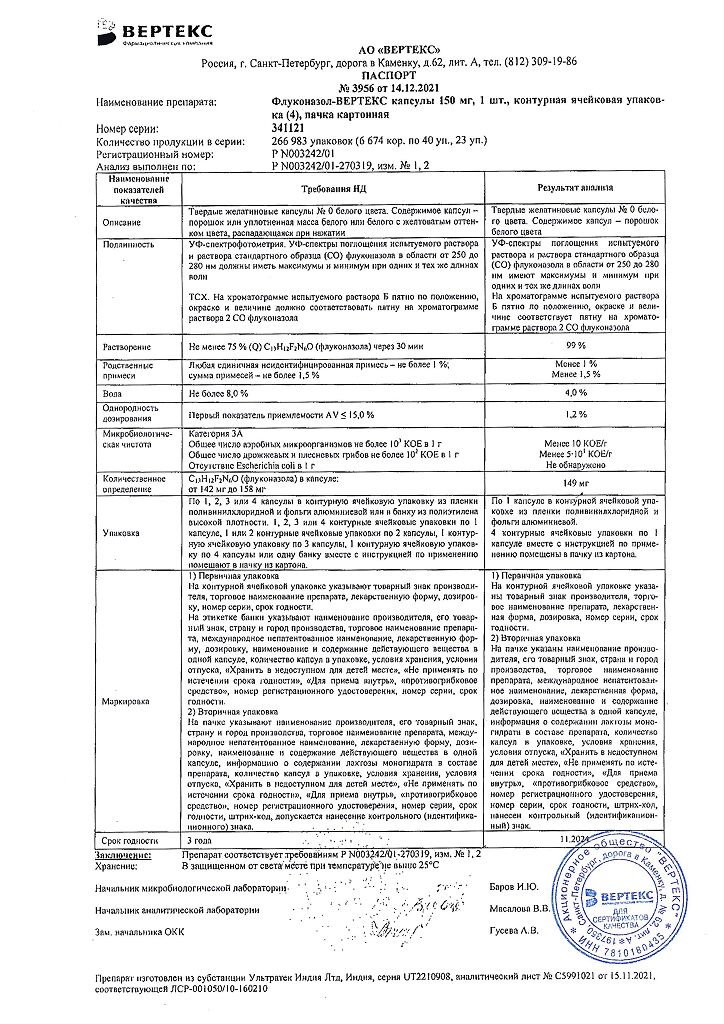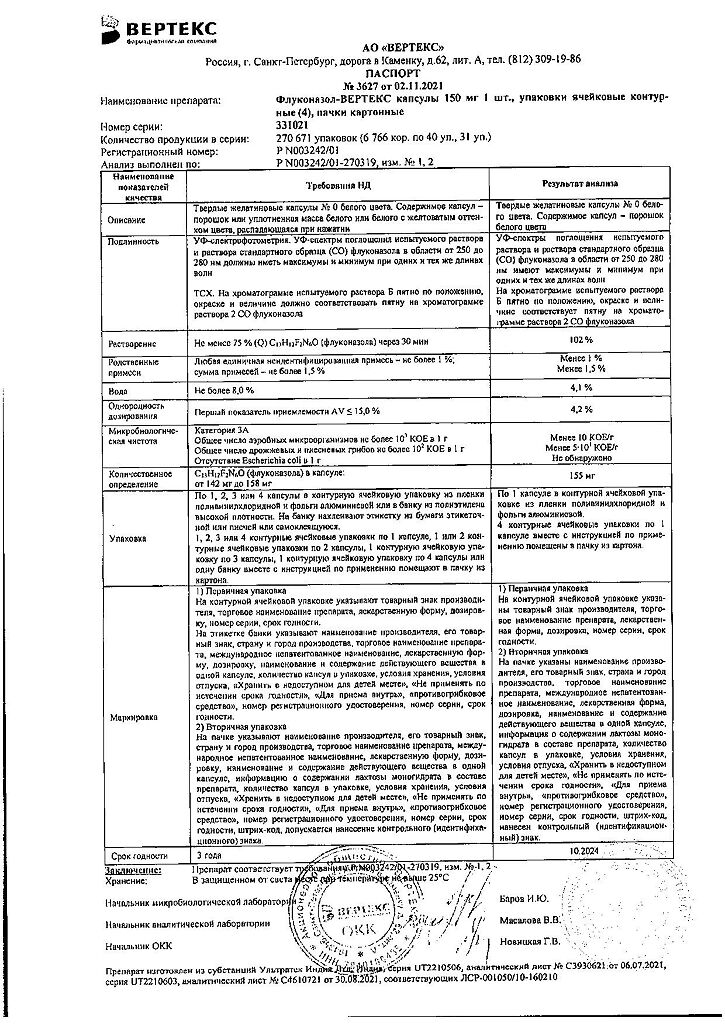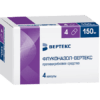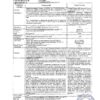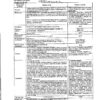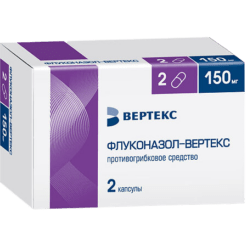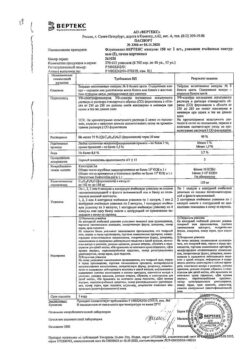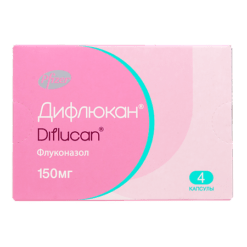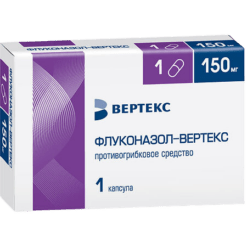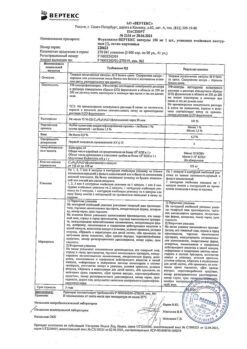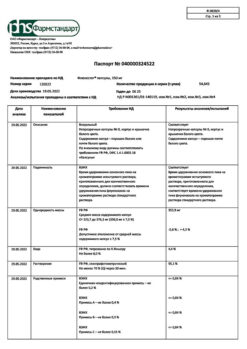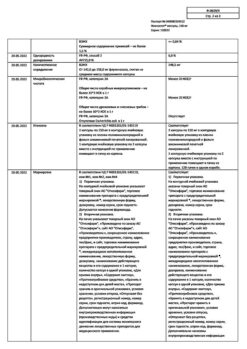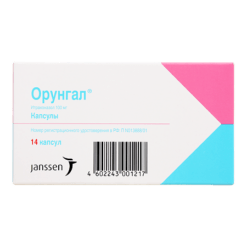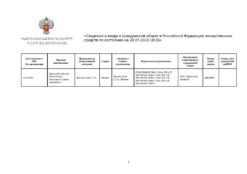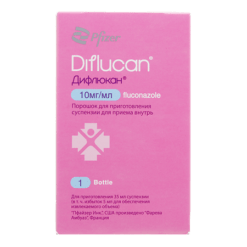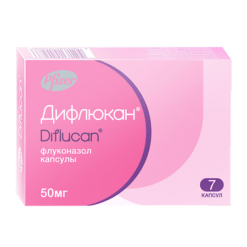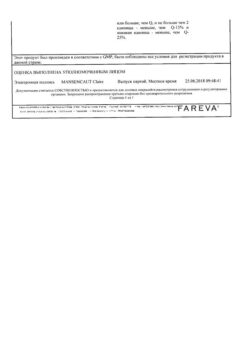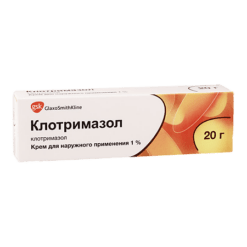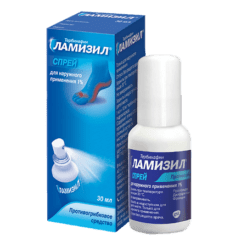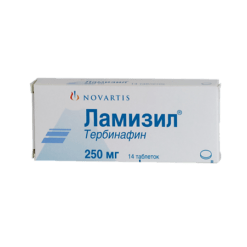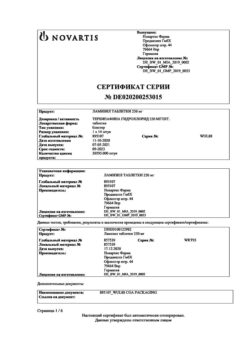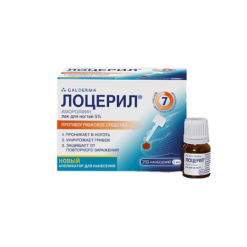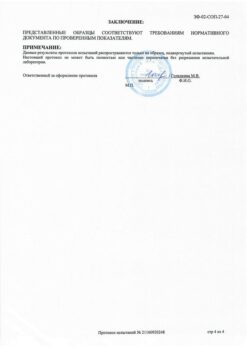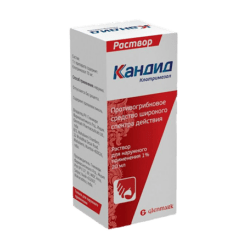No products in the cart.
Fluconazole-Vertex, 150 mg capsules 4 pcs
€3.92 €3.56
Description
Antifungal agent, has a highly specific action by inhibiting the activity of cytochrome P450-dependent fungal enzymes.
Blocks conversion of fungal cells lanosterol to ergosterol; increases cell membrane permeability, disrupts cell growth and replication. Fluconazole, being highly selective for cytochrome P450 of fungi, practically does not inhibit these enzymes in humans (in comparison with itraconazole, clotrimazole, econazole and ketoconazole it inhibits cytochrome P450 dependent oxidative processes in human liver microsomes to a lesser extent). It does not have antiandrogenic activity.
Active in opportunistic mycoses, including those caused by Candida spp. (including generalized candidiasis against immunosuppression), Cryptococcus neoformans and Coccidioides immitis (including meningitis and encephalitis), Microsporum spp. and Trichophyton spp; in endemic mycoses caused by Blastomyces dermatidis, Histoplasma capsulatum (including immunosuppression).
Indications
Indications
– cryptococcosis, including cryptococcal meningitis and other localizations of this infection (including lungs, skin), both in patients with a normal immune response and in patients with various forms of immunosuppression (including AIDS patients, organ transplants); the drug can be used to prevent cryptococcal infection in AIDS patients; – generalized candidiasis, including candidemia, disseminated candidiasis and other forms of invasive candidal infections (infections of the peritoneum, endocardium, eyes, respiratory and urinary tract).
Treatment can be carried out in patients with malignant neoplasms, patients in intensive care units, patients undergoing cytostatic or immunosuppressive therapy, as well as in the presence of other factors predisposing to the development of candidiasis;
— candidiasis of the mucous membranes, including the oral cavity and pharynx (including atrophic candidiasis of the oral cavity associated with wearing dentures), esophagus, non-invasive bronchopulmonary candidiasis, candiduria, skin candidiasis; prevention of relapses of oropharyngeal candidiasis in patients with AIDS;
– genital candidiasis: vaginal candidiasis (acute and chronic recurrent), prophylactic use to reduce the frequency of relapses of vaginal candidiasis (3 or more episodes per year);
– candidal balanitis;
– prevention of fungal infections in patients with malignant neoplasms who are predisposed to such infections as a result of chemotherapy with cytostatics or radiation therapy;
— mycoses of the skin, including mycoses of the feet, body, and groin area;
– pityriasis versicolor (lichen versicolor);
– onychomycosis;
– skin candidiasis;
— deep endemic mycoses, including coccidioidomycosis and histoplasmosis, in patients with normal immunity.
Pharmacological effect
Pharmacological effect
An antifungal agent that has a highly specific effect, inhibiting the activity of fungal enzymes dependent on cytochrome P450.
Blocks the conversion of lanosterol in fungal cells to ergosterol; increases the permeability of the cell membrane, disrupts its growth and replication. Fluconazole, being highly selective for fungal cytochrome P450, practically does not inhibit these enzymes in the human body (in comparison with itraconazole, clotrimazole, econazole and ketoconazole, it suppresses cytochrome P450-dependent oxidative processes in human liver microsomes to a lesser extent). Does not have antiandrogenic activity.
Active against opportunistic mycoses, incl. caused by Candida spp. (including generalized forms of candidiasis due to immunosuppression), Cryptococcus neoformans and Coccidioides immitis (including meningitis and encephalitis), Microsporum spp. and Trichophyton spp; for endemic mycoses caused by Blastomyces dermatidis, Histoplasma capsulatum (including immunosuppression).
Special instructions
Special instructions
Treatment must be continued until clinical and hematological remission occurs. Premature cessation of treatment leads to relapses. In rare cases, the use of fluconazole was accompanied by toxic changes in the liver, incl. with a fatal outcome, mainly in patients with serious concomitant diseases.
In the case of hepatotoxic effects associated with fluconazole, there was no obvious dependence on the total daily dose, duration of therapy, gender and age of the patient. The hepatotoxic effects of fluconazole were usually reversible; its signs disappeared after cessation of therapy. If clinical signs of liver damage that may be associated with fluconazole appear, the drug should be discontinued. People with AIDS are more likely to develop severe skin reactions when taking many drugs.
In cases where a rash develops in patients with a superficial fungal infection, and it is assessed as definitely related to fluconazole, the drug should be discontinued. If a rash appears in patients with invasive systemic fungal infections, they should be carefully monitored and fluconazole should be discontinued if bullous changes or erythema multiforme occur.
Caution must be exercised when taking fluconazole concomitantly with cisapride, rifabutin or other drugs metabolized by the cytochrome P450 system.
Active ingredient
Active ingredient
Fluconazole
Composition
Composition
Dosage 150 mg
active ingredient: fluconazole – 150.0 mg;
excipients: lactose monohydrate – 138.8 mg; corn starch – 49.0 mg; povidone K-17 (low molecular weight polyvinylpyrrolidone) – 7.0 mg; calcium stearate – 3.0 mg; colloidal silicon dioxide – 1.5 mg; sodium lauryl sulfate – 0.7 mg;
hard gelatin capsules No. 0: [titanium dioxide – 2.0%, gelatin – up to 100%].
Pregnancy
Pregnancy
The use of the drug in pregnant women is not advisable, with the exception of severe or life-threatening forms of fungal infections, when the potential benefit of fluconazole for the mother significantly outweighs the risk to the fetus.
Since the concentration of fluconazole in breast milk and plasma is the same, the use of the drug during lactation is contraindicated.
Contraindications
Contraindications
– hypersensitivity to fluconazole, other components of the drug or azole substances with a structure similar to fluconazole;
– simultaneous use of terfenadine during repeated use of fluconazole at a dose of 400 mg/day or more (see section “Interaction with other drugs”);
– simultaneous use with drugs that can prolong the QT interval and are metabolized by the CYP3A4 isoenzyme, such as cisapride, astemizole, erythromycin, pimozide, quinidine (see section “Interaction with other drugs”);
– lactose intolerance, lactase deficiency, glucose-galactose malabsorption;
– children under 3 years of age (for this dosage form).
With caution
– liver failure;
– renal failure;
– the appearance of a rash during the use of fluconazole in patients with superficial fungal infections and invasive/systemic fungal infections;
– simultaneous use of terfenadine and fluconazole at a dose of less than 400 mg/day;
– potentially proarrhythmic conditions in patients with multiple risk factors (organic heart disease, electrolyte imbalance and concomitant therapy that contributes to the development of such disorders).
Side Effects
Side Effects
The adverse events presented below are listed depending on the anatomical and physiological classification and frequency of occurrence.
The frequency of occurrence is determined as follows: often – more than 1%; infrequently – 0.1-1%; rarely – 0.01-0.1%; very rarely – less than 0.01%.
From the digestive system: loss of appetite, change in taste, nausea, diarrhea, flatulence, abdominal pain, vomiting, abdominal pain; rarely – impaired liver function (jaundice, hepatocellular necrosis, hyperbilirubinemia, increased activity of alanine aminotransferase (ALT), aspartate aminotransferase (AST) and alkaline phosphatase (ALP), hepatitis, hepatonecrosis), incl. heavy.
From the nervous system: headache, dizziness, excessive fatigue; rarely – convulsions.
From the hematopoietic organs: rarely – leukopenia, thrombocytopenia (bleeding, petechiae), neutropenia, agranulocytosis.
Allergic reactions: skin rash; rarely – exudative erythema multiforme (including Stevens-Johnson syndrome), toxic epidermal necrolysis (Lyell’s syndrome), anaphylactoid reactions (including angioedema, facial edema, urticaria, skin itching).
From the cardiovascular system: increased duration of the QT interval, ventricular fibrillation/flutter.
Others: rarely – impaired renal function, alopecia, hypercholesterolemia, hypertriglyceridemia, hypokalemia.
Interaction
Interaction
When fluconazole is used with warfarin, the prothrombin time increases (by an average of 12%). It is recommended to monitor prothrombin time when fluconazole is combined with coumarin anticoagulants. Fluconazole increases plasma T1/2 of oral hypoglycemic agents – sulfonylurea derivatives (chlorpropamide, glibenclamide, glipizide, tolbutamide) in healthy people. The combined use of Fluconazole and oral hypoglycemic agents in patients with diabetes mellitus is allowed, but the doctor must keep in mind the possibility of developing hypoglycemia.
Concomitant use of fluconazole and phenytoin may lead to an increase in plasma phenytoin concentrations to a clinically significant extent. Therefore, if it is necessary to use these drugs together, it is necessary to monitor phenytoin concentrations with dose adjustment in order to maintain drug concentrations within the therapeutic interval. The combination with rifampicin leads to a decrease in AUC by 25% and a shortening of T1/2 of fluconazole from plasma by 20%.
Therefore, in patients receiving rifampicin at the same time, it is advisable to increase the dose of fluconazole. It is recommended to monitor the concentration of cyclosporine in the blood in patients receiving fluconazole, because when using fluconazole and cyclosporine in patients with a kidney transplant, taking fluconazole at a dose of 200 mg/day leads to a slow increase in the concentration of cyclosporine in plasma.
Patients receiving high doses of theophylline or who are at risk of developing theophylline toxicity should be monitored for symptoms of theophylline overdose, as simultaneous administration of fluconazole leads to a decrease in the clearance of theophylline from blood plasma.
There are reports of interaction between fluconazole and rifabutin, accompanied by an increase in the serum concentration of the latter. Cases of uveitis have been described with the simultaneous use of fluconazole and rifabutin. Patients receiving rifabutin and fluconazole simultaneously should be carefully monitored.
In patients receiving a combination of fluconazole and zidovudine, an increase in the concentration of zidovudine is observed, which is caused by a decrease in the conversion of the latter to its main metabolite, so an increase in the side effects of zidovudine should be expected. With the simultaneous use of fluconazole, terfenadine and cisapride, cases of adverse reactions from the heart, including pirouette-type arrhythmia, have been described. Concomitant use of fluconazole and hydrochlorothiazide can lead to an increase in fluconazole concentrations by 40%.
Increases the concentration of midazolam, and therefore increases the risk of developing psychomotor effects (more pronounced when fluconazole is used orally than intravenously).
Increases the concentration of tacrolimus, which increases the risk of nephrotoxicity.
Overdose
Overdose
There have been reports of fluconazole overdose, and in one case, a 42-year-old patient infected with human immunodeficiency virus developed hallucinations and paranoid behavior after taking 8200 mg of fluconazole. The patient was hospitalized, his condition returned to normal within 48 hours.
In case of overdose, symptomatic treatment (including supportive measures and gastric lavage) can provide an adequate effect.
Fluconazole is excreted primarily through the kidneys, so formed diuresis may likely accelerate the elimination of the drug. A hemodialysis session lasting 3 hours reduces the concentration of fluconazole in the blood plasma by approximately 50%.
Recommendations for use
Recommendations for use
Inside. For adults and children over 15 years of age (body weight over 50 kg) for cryptococcal meningitis and cryptococcal infections of other localizations, 400 mg (8 capsules of 50 mg each) is usually prescribed on the first day, and then treatment is continued at a dose of 200 mg (4 capsules of 50 mg each) – 400 mg (8 capsules of 50 mg each) 1 time / day.
The duration of treatment for cryptococcal infections depends on clinical effectiveness confirmed by mycological examination; for cryptococcal meningitis, the course of treatment should be at least 6-8 weeks. To prevent relapse of cryptococcal meningitis in patients with AIDS, after completing the full course of primary therapy, fluconazole is prescribed at a dose of 200 mg (4 capsules of 50 mg) / day for a long period of time. For candidemia, disseminated candidiasis and other invasive candidal infections, on the first day the dose is 400 mg (8 capsules of 50 mg), and then 200 mg (4 capsules of 50 mg) / day.
If clinical effectiveness is insufficient, the dose of the drug can be increased to 400 mg (8 capsules of 50 mg) / day. The duration of therapy depends on the clinical effectiveness of the drug (100% of the recommended dose). When CC is from 11 to 50 ml/min, 50% of the recommended dose or the usual dose is used 1 time every 2 days.
For patients with impaired renal function, fluconazole is administered according to the following regimen.
Creatinine clearance Interval/daily dose more than 40 ml/min 24 hours (usual dosing regimen) 21-40 ml/min 48 hours (once every two days) or half the usual daily dose (once every 24 hours) 10-20 ml/min 72 hours (once every three days) or 1/2 the usual daily dose (1/3 every 24 hours)
For patients on hemodialysis, one dose of the drug is administered after each hemodialysis session.
Storage conditions
Storage conditions
In a dry place, protected from light, at a temperature not exceeding 25 ° C
Shelf life
Shelf life
3 years
Manufacturer
Manufacturer
Vertex, Russia
Additional information
| Shelf life | 3 years |
|---|---|
| Conditions of storage | In a dry, protected from light, at a temperature not exceeding 25 ° C |
| Manufacturer | Vertex, Russia |
| Medication form | capsules |
| Brand | Vertex |
Other forms…
Related products
Buy Fluconazole-Vertex, 150 mg capsules 4 pcs with delivery to USA, UK, Europe and over 120 other countries.


